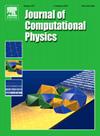High-order inverse Lax-Wendroff procedure for compressible fluid-structure interaction problems
IF 3.8
2区 物理与天体物理
Q2 COMPUTER SCIENCE, INTERDISCIPLINARY APPLICATIONS
引用次数: 0
Abstract
In this study, we propose a global high-order approach for fluid-structure interaction (FSI) problems involving compressible inviscid flows and deformable elastic solids. A partitioned coupling strategy is employed to solve the fluid and solid equations. The compressible Euler equations in the fluid domain are solved using a high-order finite difference weighted essentially non-oscillatory (WENO) method on fixed Cartesian Eulerian grids. In the solid domain, the linear elastodynamic equations are discretized via the Lagrangian discontinuous Galerkin (DG) finite element method on unstructured meshes. To handle the moving interface between the fluid and solid domains, we develop a high-order treatment derived from the inverse Lax-Wendroff (ILW) boundary scheme. This approach avoids the need for mesh generation and sub-iterations at each time step, simplifying implementation. Furthermore, the specialized interface treatment ensures stability in challenging cases, such as those involving light solids coupled with heavy fluids. Stability analysis for linear systems further demonstrates the robustness of the method. We validate the proposed approach through numerical tests on one- and two-dimensional problems. The results demonstrate that our method could achieve third-order accuracy for smooth solutions, handle shock induced FSI problems without oscillation, and remain stable across a wide range of material parameters.
可压缩流固耦合问题的高阶Lax-Wendroff逆过程
在这项研究中,我们提出了一个涉及可压缩无粘流和可变形弹性固体的流固相互作用(FSI)问题的全局高阶方法。采用分区耦合策略求解流固方程。在固定的笛卡尔欧拉网格上,采用高阶有限差分加权本质非振荡(WENO)方法求解流体域中的可压缩欧拉方程。在非结构网格上,采用拉格朗日不连续伽辽金(DG)有限元法对线性弹性动力学方程进行离散。为了处理流体和固体域之间的移动界面,我们开发了一种由逆Lax-Wendroff (ILW)边界格式导出的高阶处理。这种方法避免了在每个时间步生成网格和子迭代的需要,简化了实现。此外,特殊的界面处理确保了在具有挑战性的情况下的稳定性,例如涉及轻固体和重流体的情况。对线性系统的稳定性分析进一步证明了该方法的鲁棒性。通过一维和二维问题的数值实验验证了所提出的方法。结果表明,我们的方法可以达到光滑解的三阶精度,在没有振荡的情况下处理冲击诱导的FSI问题,并且在广泛的材料参数范围内保持稳定。
本文章由计算机程序翻译,如有差异,请以英文原文为准。
求助全文
约1分钟内获得全文
求助全文
来源期刊

Journal of Computational Physics
物理-计算机:跨学科应用
CiteScore
7.60
自引率
14.60%
发文量
763
审稿时长
5.8 months
期刊介绍:
Journal of Computational Physics thoroughly treats the computational aspects of physical problems, presenting techniques for the numerical solution of mathematical equations arising in all areas of physics. The journal seeks to emphasize methods that cross disciplinary boundaries.
The Journal of Computational Physics also publishes short notes of 4 pages or less (including figures, tables, and references but excluding title pages). Letters to the Editor commenting on articles already published in this Journal will also be considered. Neither notes nor letters should have an abstract.
 求助内容:
求助内容: 应助结果提醒方式:
应助结果提醒方式:


